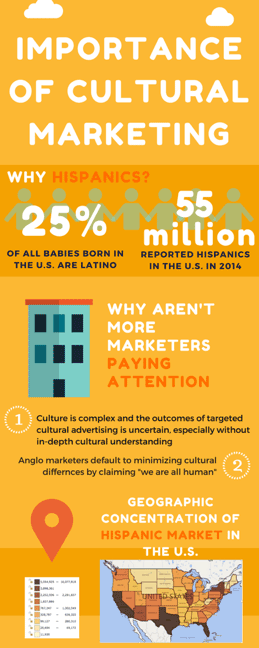The Importance of Targeted Cultural Marketing in a Diverse U.S. Consumer Market
November 14, 2017
 By Kayli Bomar / Florida State University
By Kayli Bomar / Florida State University
The Importance of Targeted Cultural Marketing in a Diverse U.S. Consumer Market
The advertising and consumer industry has completely transformed over the past 50 years. Every year professionals are discovering new and innovative ways of research and implementation to effectively reach the most consumers within their target market. Recently, the concept of incorporating cultural considerations in marketing has allowed industries to reach a new level of consumer insight. Although complex and not an easy feat to delve in to researching, there are endless benefits of taking the time to understand culture in regards to marketing. But, many businesses are still refusing to do so due to culture’s complexity and a tendency to minimize cultural differences. Furthermore, the U.S. Hispanic market is a perfect example of a uniquely targetable audience due to its size and shared values. From a business standpoint, marketers cannot bear to lessen the importance of cultural intelligence without drastically affecting their performance (Magnusson, Westjohn, Semenov, Randrianasolo, & Zdravkovic, 2013).
Although research shows that not taking the time to understand cultural differences among consumers is a huge mistake, many companies are still underestimating culture’s impact. Businesses are hesitant to explore cultural differences in their campaigns because they are still relying on an old way of thinking. Korzenny and Chapa explain that some people believe that because we are all human beings and have the same general needs, we should react to stimuli the same (2017). Korzenny and Chapa then go on to explain that this is the outdated idea that as humans, we all have a basic innate nature. While that can be true in some instances, in regards to response to advertising, culture makes a world of a difference. Advertising is about appealing to a consumer and getting them to trust, value and relate to your brand and form a connection. For example, although all humans have a basic need for food, different methods of advertising this food will appeal to different cultural groups. In order to directly appeal to your target audience, you must know what makes them tick. Marketers do themselves a disservice by thinking that in today’s melting pot society, people can all be treated the same.
Another reason that marketers continue to underestimate culture in marketing is due to culture’s complex nature. Understanding culture is difficult due to its diverse elements and meanings. Understanding and articulating one’s own culture is difficult enough, because it is typically just an innate part of our being and way of life. Taking a step further and attempting to fully understand the interworkings of another culture can be even more difficult. This daunting task can often deter marketers from this research. “Understanding cultural beliefs requires primary and secondary research,” (Chapa, Korzenny, B., Korzenny, F., 2017). It is easier for companies to disregard cultural differences in order to save time and stress, but as Korzenny and Chapa remind us, acting on ignorant cultural assumptions is both wasteful and irresponsible (2017). It is important to understand that marketing companies use the client’s money to get results for them, and the riskier they are in their methods, the more they risk not meeting the client’s expectations. That is why many companies shy away from the unknown and the uncertainty of a culturally diverse campaign. Because culture is so complex, there are many things that could go wrong in a campaign and not give them the results they want. The fear of the unknown keeps marketers from taking risk, and researchers remind them that “it is in the area of cross‐cultural communications that most blunders in international marketing occur,” (Kale, 1991). But, if marketers take the time and do the research necessary to increase their cultural intelligence, they will reap the benefits.
Although many marketing professionals are still underestimating culture in the advertising process, for those companies that are considering its impact, the Hispanic market is a uniquely targetable market to focus on. Hispanic origin is defined by the United States Census Bureau as “the heritage, nationality, lineage, or country of birth of the person or the person’s parents or ancestors before arriving in the United States,” (“Hispanic Origin”, n.d.). In 2014 there were a reported 55 million Hispanics in the U.S. (Korzenny et al, 2017). This is a massive market size that cannot be ignored. Also, what makes this market unique is its emotional regard for the Spanish language. One survey respondent described his connection with the Spanish language in his own words, “It speaks not of the identity which I project in public now, but rather my personality and sense of self since birth,” (Korzenny et al, 2017). This deeply engrained cultural bond with the language unifies the market and makes them easy to target. Hispanic media channels have seen growth over the years and remained an efficient way to get in touch with the Hispanic market. Finally, there is an obvious geographic concentration of U.S. Hispanics. Large majorities reside in Florida, Texas and California. This knowledge makes it easier to target smaller, centralized markets that will reach a majority of your desired audience.
To sum up, many marketing companies around the country are making a grave mistake by underestimating the value of culture in marketing. Although it is complex, difficult to understand and time-consuming, understanding is essential in today’s economy where consumers are more diverse than ever. As skepticism of advertising has risen, marketers need to rely on consumer insights, including cultural insights, in order to deliver an effective marketing campaign (De Pechpeyrou and Odou, 2012). Specifically, the Hispanic market in the U.S. is uniquely targetable based on their shared culture and market size.
References
Bureau, U. C. (n.d.). Hispanic Origin. Retrieved September 17, 2017, retrieved from https://www.census.gov/topics/population/hispanic-origin.html
De Pechpeyrou, P., and Odou, P. “Consumer Skepticism and Promotion Effectiveness [Abstract]”. Recherche Et Applications En Marketing (English Edition) (AFM c/o ESCP-EAP), vol. 27, no. 2, June 2012, pp. 45–69.
Kale, S. (1991). “Culture-specific Marketing Communications: An Analytical
Approach” [Abstract]. International Marketing Review, 8.
Korzenny, F., Korzenny, B. A., & Chapa, S. (2017). Hispanic marketing: The power of the new Latino consumer. London: Routledge.
Magnusson, P., Westjohn S., Semenov, Alexey. V., Randrianasolo, A. A., and Zdravkovic, S. (2013). “The Role of Cultural Intelligence in Marketing Adaptation and Export Performance.” Journal of Marketing Research, 21.4, 44-61.

References for Infographic
Korzenny, F., Chapa, S. & Korzenny, B. A (2017). Hispanic Marketing: The power of the New Latino consumer. London: Routledge.






























